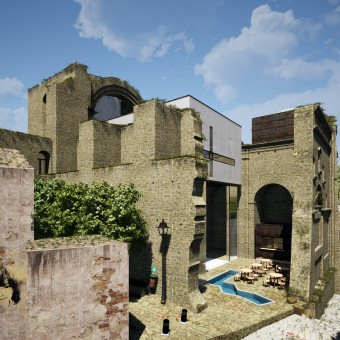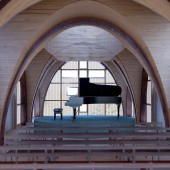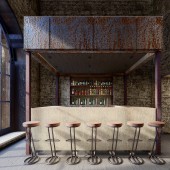Chiesa Diruta Concert Hall and Library by Constantinos Yanniotis |
Home > Winners > #148126 |
 |
|
||||
| DESIGN DETAILS | |||||
| DESIGN NAME: Chiesa Diruta PRIMARY FUNCTION: Concert Hall and Library INSPIRATION: The Chiesa Diruta of SS Luca e Giuliano at Grottole is the ideal setting for the transformation of the ruined monument into a vibrant, cultural center that will serve as a landmark for the entire region. The core idea behind design is the creation of a "Temple" inside the original stone wall monument that floats 7 m above the ground floor level. This gesture frees the space of the main Temple floor, allowing people to visit the site and enjoy the breathtaking view over the Basento river valley. UNIQUE PROPERTIES / PROJECT DESCRIPTION: The Chiesa Diruta is a unique Renaissance church with an elliptical dome. Visitors enter the site through the fallen northwest stone wall corner and cross the outdoor seating area that lead to the weather protected foyer which is bounded by perimetric folded glazing doors. This space may be used as a secondary event venue during summertime or as art exhibitions. The two storey Municipal Library is located at the opposite side of the monument accessible from Via della Resistenza. OPERATION / FLOW / INTERACTION: The design consists of two separate functions, the Concert Hall and the Municipal Library, connected via a narrow path on the north side of the church. All circulations within the building are accessible through flush thresholds and ramps. The Gift Shop and the Bar are located to the south side of the transept. Two elevators located on the north, lead to the Concert Hall level, on the opposite side of which are the dressing rooms and an outdoor bridge path leading to the Director Office. PROJECT DURATION AND LOCATION: The project started in December 2020 and ended in March 2021. It is located in Grottole, a village perched on a hill in the countryside of Basilicata, the origins of which date back to the 12th century. It consists the Bureau's proposal submitted in an International Architecture Competition Call, which requested to reuse the space of a ruined Renaissance church, known as Chiesa Diruta, as a Concert Hall. FITS BEST INTO CATEGORY: Architecture, Building and Structure Design |
PRODUCTION / REALIZATION TECHNOLOGY: The main material used for the new building of the Concert Hall is a 60mm thick Polycarbonate Sheet Wall. The use of this material with its relative translucency, achieves a neutral integration of the modern Concert Hall building into the monumental Temple. When nighttime events take place, the floating volume of the Hall, reflects a gentle and warm light, which illuminates the surroundings, thus turning the Chiesa Diruta into a vibrant space that serves as a landmark for the region. SPECIFICATIONS / TECHNICAL PROPERTIES: The new development requires the design of spaces that intervene between the basic levels of the stone wall church. In order to differentiate the new building from the old monument, a reversible and flexible structure has been implemented. The primary and secondary supporting system of the polycarbonate sheet panels consist of a metallic grid connected to its aluminum casements. The floors of both the concert hall and library are covered by maple parquets, while the foyer floor by white marble. A membrane layer protects the subfloor of the church. TAGS: Monument, Concert Hall, Library, Renaissance Church RESEARCH ABSTRACT: The integration of the new Concert Hall and Library was derived after an in depth research of the Architecture history of Renaissance Temples. All roof constructions as well as the free standing boxes hosting certain functions (bar, tickets, tourist office, etc.)are covered with patina metal panels. The metallic elliptical beams that provide stiffness to the concert hall structure, along with the wooden interior cover, reflect the stone groin vaults predecessors. CHALLENGE: The most demanding design issues, were the integration of a modern concert hall into a Renaissance church monument, and the structural detailing that would not compromise either the new building use or the form of the monument. The exact position and height of the floating concert hall, were determined with regards to the arched niches of the nave and the relative height of the perimetric stone moldings. ADDED DATE: 2023-02-08 13:19:29 TEAM MEMBERS (1) : IMAGE CREDITS: Image #1, Constantinos Yanniotis, Architect, 2023 Image #1, Constantinos Yanniotis, Architect, 2023 Image #3, Vassilis Symeonidis, Visualiser, 2023 Image #3, Vassilis Symeonidis, Visualiser, 2023 Video Credits, Reuse Italy, Constantinos Yanniotis, 2023 |
||||
| Visit the following page to learn more: https://bit.ly/3RzQtit | |||||
| AWARD DETAILS | |
 |
Chiesa Diruta Concert Hall and Library by Constantinos Yanniotis is Winner in Cultural Heritage and Culture Industry Design Category, 2022 - 2023.· Read the interview with designer Constantinos Yanniotis for design Chiesa Diruta here.· Press Members: Login or Register to request an exclusive interview with Constantinos Yanniotis. · Click here to register inorder to view the profile and other works by Constantinos Yanniotis. |
| SOCIAL |
| + Add to Likes / Favorites | Send to My Email | Comment | Testimonials | View Press-Release | Press Kit | Translations |
Did you like Constantinos Yanniotis' Cultural Heritage Design?
You will most likely enjoy other award winning cultural heritage design as well.
Click here to view more Award Winning Cultural Heritage Design.








